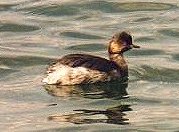
Herts Bird Club Bulletin, covering July and August 1998
Main headlines
Radio-tagged Bittern at Amwell and Blue-winged Teal at Hilfield Park Reservoir
Weather summary for the period
July remained unsettled with light south-westerly winds. It was quite sunny and warm at times. August was a month of mixed weather with strong winds and rain at times but improving towards the end with a warm, more settled spell.
Bird summary
The four young Black-necked Grebes fledged successfully at Hilfield Park Reservoir and were long gone by the time you received your Bulletin.
 Black-necked Grebe (Gareth Watkins)
Black-necked Grebe (Gareth Watkins)
There was a summer report of a French-ringed Cormorant at Maple Lodge Nature Reserve.
An amazing record came from Amwell Gravel Pit where a radio-tagged Bittern was identified as a bird from the population being studied at the RSPB's Minsmere reserve in Suffolk. Last recorded on 23rd August at Amwell, the bird was back at Minsmere by the 25th. Normally thought of as a winter visitor to Hertfordshire, there have been a number of summer/early autumn occurrences. At Tring Reservoirs, for instance, there has been one July, four August and a September record which may have been birds of British origins.
Another notable heron was a Little Egret, also at Amwell.
Wildfowl records in summer often seem to contain a fair share of suspect characters and this was indeed the case: from downright escapes like Black Swan, through 'iffy' Ruddy Shelduck to almost acceptable Bar-headed Goose. Where Red-crested Pochard fits into this picture is open to conjecture. Is the feral breeding population tickable or do we have to prove foreign immigration?
No problems with the four Garganeys seen during the period, and the regrettably short-staying Blue-winged Teal (a drake in almost full eclipse) at Hilfield Park Reservoir turned up at the appropriate time of year and with three others in the country for back up.
There was a Red Kite seen at St Albans while Buzzards continued to make their presence felt.
Calling Quails in the north of the county was a good record.
Wader passage is usually a feature of this period so records of Oystercatcher, Dunlin, Ruff, Black-tailed Godwit, Curlew (with a single flock of 19 at Tyttenhanger Gravel Pits) and Spotted Redshank were welcome amongst the more common species.
A single Little Gull was seen and two Yellow-legged Gulls appeared at a popular time for this species. There was a Sandwich Tern at Tring Reservoirs.
With the failing fortunes of House Martin, it was good to hear of a colony of 36 nests which must be near the highest count for Herts - unless you know different.
There was still a Tree Pipit singing on Berkhamsted Common in July but passage of passerines had started by August with a Redstart, reasonable numbers of Whinchats (including seven birds together at Blackbridge) and a trickle of Wheatears passing through. Grasshopper Warblers are usually confined to the Lee Valley in spring, so singing birds at Tyttenhanger Gravel Pits, Sandridge and Wilstone Reservoir were good records.
Lee Marshall has included in the listing all records of Spotted Flycatcher submitted and a number of these were of breeding pairs or birds with young.
Reports of Willow Tit, however, are becoming increasingly scarce so the appearance of a juvenile at Berkhamsted Common, where none has been seen for three years, was encouraging.
There were a few breeding records for Tree Sparrow, just maintaining them as breeding in the county. Please do not forget to submit all records of this greatly diminished species.
A flock of 15 Redpolls were a surprising find at Tyttenhanger Gravel Pits at this time of year. What sub-species were they Joan?